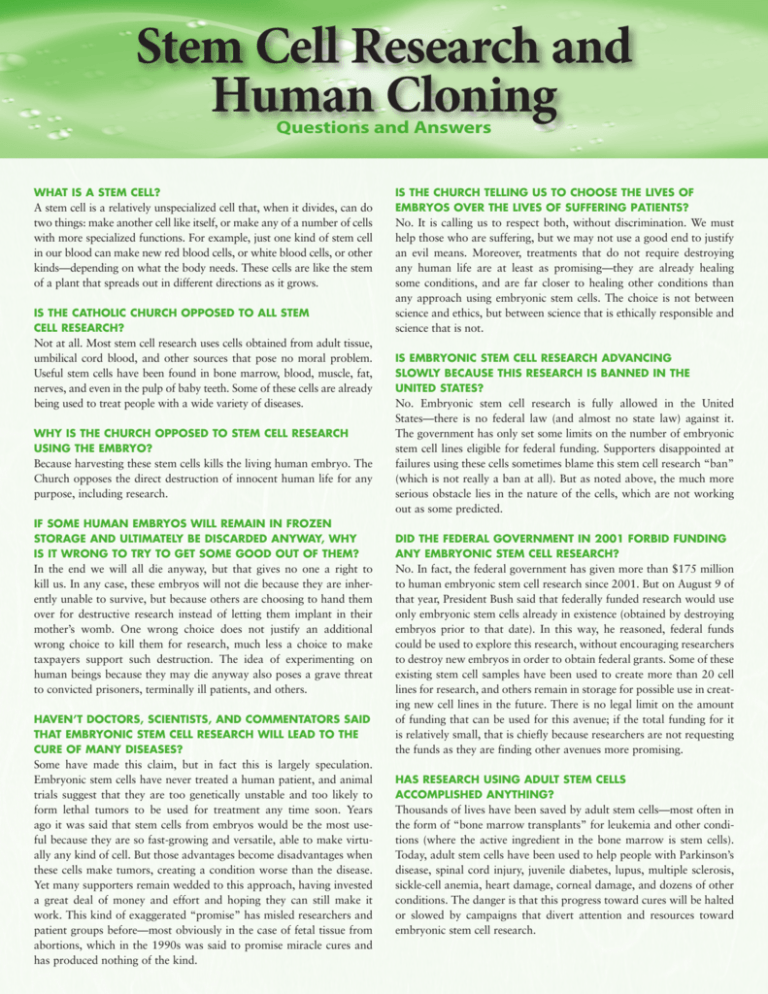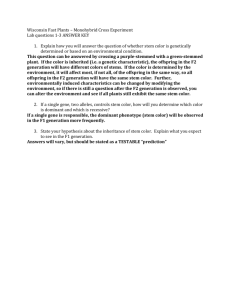
Stem Cell Research and
Human Cloning
Questions and Answers
What is a stem cell?
A stem cell is a relatively unspecialized cell that, when it divides, can do
two things: make another cell like itself, or make any of a number of cells
with more specialized functions. For example, just one kind of stem cell
in our blood can make new red blood cells, or white blood cells, or other
kinds—depending on what the body needs. These cells are like the stem
of a plant that spreads out in different directions as it grows.
Is the catholic Church opposed to all stem
cell research?
Not at all. Most stem cell research uses cells obtained from adult tissue,
umbilical cord blood, and other sources that pose no moral problem.
Useful stem cells have been found in bone marrow, blood, muscle, fat,
nerves, and even in the pulp of baby teeth. Some of these cells are already
being used to treat people with a wide variety of diseases.
Why is the Church opposed to stem cell research
using the embryo?
Because harvesting these stem cells kills the living human embryo. The
Church opposes the direct destruction of innocent human life for any
purpose, including research.
If some human embryos will remain in frozen
storage and ultimately be discarded anyway, why
Is it wrong to try to get some good out of them?
In the end we will all die anyway, but that gives no one a right to
kill us. In any case, these embryos will not die because they are inherently unable to survive, but because others are choosing to hand them
over for destructive research instead of letting them implant in their
mother’s womb. One wrong choice does not justify an additional
wrong choice to kill them for research, much less a choice to make
taxpayers support such destruction. The idea of experimenting on
human beings because they may die anyway also poses a grave threat
to convicted prisoners, terminally ill patients, and others.
Haven’t doctors, scientists, and commentators said
that embryonic stem cell research will lead to the
cure of many diseases?
Some have made this claim, but in fact this is largely speculation.
Embryonic stem cells have never treated a human patient, and animal
trials suggest that they are too genetically unstable and too likely to
form lethal tumors to be used for treatment any time soon. Years
ago it was said that stem cells from embryos would be the most useful because they are so fast-growing and versatile, able to make virtually any kind of cell. But those advantages become disadvantages when
these cells make tumors, creating a condition worse than the disease.
Yet many supporters remain wedded to this approach, having invested
a great deal of money and effort and hoping they can still make it
work. This kind of exaggerated “promise” has misled researchers and
patient groups before—most obviously in the case of fetal tissue from
abortions, which in the 1990s was said to promise miracle cures and
has produced nothing of the kind.
Is the Church telling us to choose the lives of
embryos over the lives of suffering patients?
No. It is calling us to respect both, without discrimination. We must
help those who are suffering, but we may not use a good end to justify
an evil means. Moreover, treatments that do not require destroying
any human life are at least as promising­—they are already healing
some conditions, and are far closer to healing other conditions than
any approach using embryonic stem cells. The choice is not between
science and ethics, but between science that is ethically responsible and
science that is not.
Is embryonic stem cell research advancing
slowly because this research is banned in the
united states?
No. Embryonic stem cell research is fully allowed in the United
States—there is no federal law (and almost no state law) against it.
The government has only set some limits on the number of embryonic
stem cell lines eligible for federal funding. Supporters disappointed at
failures using these cells sometimes blame this stem cell research “ban”
(which is not really a ban at all). But as noted above, the much more
serious obstacle lies in the nature of the cells, which are not working
out as some predicted.
Did the federal government in 2001 forbid funding
any embryonic stem cell research?
No. In fact, the federal government has given more than $175 million
to human embryonic stem cell research since 2001. But on August 9 of
that year, President Bush said that federally funded research would use
only embryonic stem cells already in existence (obtained by destroying
embryos prior to that date). In this way, he reasoned, federal funds
could be used to explore this research, without encouraging researchers
to destroy new embryos in order to obtain federal grants. Some of these
existing stem cell samples have been used to create more than 20 cell
lines for research, and others remain in storage for possible use in creating new cell lines in the future. There is no legal limit on the amount
of funding that can be used for this avenue; if the total funding for it
is relatively small, that is chiefly because researchers are not requesting
the funds as they are finding other avenues more promising.
Has research using adult stem cells
accomplished anything?
Thousands of lives have been saved by adult stem cells—most often in
the form of “bone marrow transplants” for leukemia and other conditions (where the active ingredient in the bone marrow is stem cells).
Today, adult stem cells have been used to help people with Parkinson’s
disease, spinal cord injury, juvenile diabetes, lupus, multiple sclerosis,
sickle-cell anemia, heart damage, corneal damage, and dozens of other
conditions. The danger is that this progress toward cures will be halted
or slowed by campaigns that divert attention and resources toward
embryonic stem cell research.
What is human cloning and how is it related to
stem cell research?
Copyright © 2004, 2008, United States Conference of Catholic Bishops,
Washington, DC. All rights reserved. Parishes and schools have permission
to reproduce this document in this format for free distribution. If you take
advantage of this offer, please inform us at publications@usccb.org so we can
track usage.
TES CONFE
TA
TH
pms 341
O LIC BIS
HO
TH
E OF
NC
RE
TES CONFE
TA
CA
Cloning is a depersonalized way to reproduce, in which human beings
are manufactured in the laboratory to preset specifications. It is not a
worthy way to bring a new human being into the world. When done for
stem cell research, it involves the moral wrong of all embryonic stem cell
research (destroying an innocent human life for possible benefit to others) plus an additional wrong: It creates human beings solely in order to
Revised, June 2008
CA
Why does the Church oppose human cloning?
Stem Cell Research and Human Cloning: Questions and Answers was developed
as a resource by the Secretariat for Pro-Life Activities of the United States
Conference of Catholic Bishops (USCCB). It was reviewed by the committee chairman, Cardinal William Keeler, and authorized for publication by the undersigned.
Msgr. William P. Fay
General Secretary, USCCB
E OF
NC
RE
In human cloning, the DNA from the nucleus of a person’s body cell is
inserted into an egg whose own genetic material has been removed, and
the egg is then stimulated to begin embryonic development. The resulting cloned embryo would genetically be an almost identical twin to the
person supplying the body cell. This research overlaps with the stem cell
issue. That is, human cloning might be done to create an embryo who will
be destroyed to provide stem cells genetically matched to a patient, so the
cells will not be rejected as foreign tissue. But some cloning research is
done for other purposes­—for example, to create embryos with devastating illnesses from the body cells of sick patients, to study the early progress of that disease. Most embryonic stem cell research involves embryos
created by in vitro fertilization, not cloning.
For the U.S. bishops’ official 2008 policy statement “On
Embryonic Stem Cell Research” and for more information, see
www.usccb.org/prolife/issues/bioethic.
PS
Many private foundations and for-profit biotechnology companies
fund stem cell research, but the federal government (especially through
the National Institutes of Health) remains the largest source of funds.
The government’s funding priorities have a large influence on the direction that medical research takes. Since available research funds began
being diverted toward exploring embryonic stem cell research, some
very promising adult stem cell avenues for treating juvenile diabetes,
spinal cord injury, Parkinson’s disease, etc. have been underappreciated
and underfunded. Many advances in these fields have emerged from
other countries.
PS
Who is funding stem cell research? What
role is federal funding playing in determining
research priorities?
No. Serious moral concerns about these practices have been raised by
an array of both religious and secular groups, including some who
disagree with the Catholic Church about abortion—Friends of the
Earth, the United Methodist Church, etc. The human cloning ban
supported by the Church has been approved twice by the House of
Representatives by an overwhelming bipartisan majority. Many other
countries (including Canada, France, Italy, Germany and Norway) have
passed similar bans. Opposition to the idea of treating early human life
as a mere object or commodity in the laboratory transcends religious
and political divisions.
S
Because these cells come from the patient, they are an exact match and
will not be rejected by the body as foreign tissue. Also, because no foreign substance is placed in the body, there are fewer regulatory barriers
to their medical use.
Does opposition to cloning and embryonic stem
cell research come only from one theological or
political view?
UNITED
What are the advantages of harvesting
donor cells from the intended recipient of
the stem cell therapy?
Yes. For example, in November 2007 several teams of scientists discovered a way to “reprogram” ordinary adult cells to produce cells with the
versatility of cells obtained from embryos. These “induced pluripotent
stem cells” or “iPS cells” pose no serious moral problem, are easier to
produce than embryonic stem cells, and can be tailor-made as an exact
genetic match to each patient. Many experts say advances like this will
make stem cell research that requires destroying embryos obsolete.
S
It is an ongoing, living colony of stem cells in a laboratory, from which
cells can be obtained for research or other uses. Sometimes these are
called “immortal” cell lines, but that is misleading because they do
eventually deteriorate. Embryonic stem cells are said to be easier to
grow in a stem cell line, but they also tend to develop serious genetic
abnormalities associated with cancer.
Can cells with the properties of embryonic stem
cells be obtained without destroying embryos?
UNITED
What is a stem cell line?
kill them for their cells. This is the ultimate reduction of a fellow human
being to a mere means, to an instrument of other people’s wishes.
O LIC BIS H
O
United States Conference of Catholic Bishops
3211black
Fourth Street, N.E.
Washington, D.C. 20017-1194
TES CONFE
TA
E OF
NC
RE
S
Yes, like donated blood or bone marrow, they can be frozen and
banked. In 2003, for example, Congress approved funds to help create
a nationwide umbilical cord blood stem cell bank, in light of the many
clinical benefits being discovered from these cells now usually discarded
after live births. Many of the embryonic stem cell samples eligible for
federally funded research under the current policy also remain frozen in
banks, to be thawed and turned into stem cell lines when needed.
UNITED
Can stem cells be stored in a bank?
c92-m24-y72-k10







